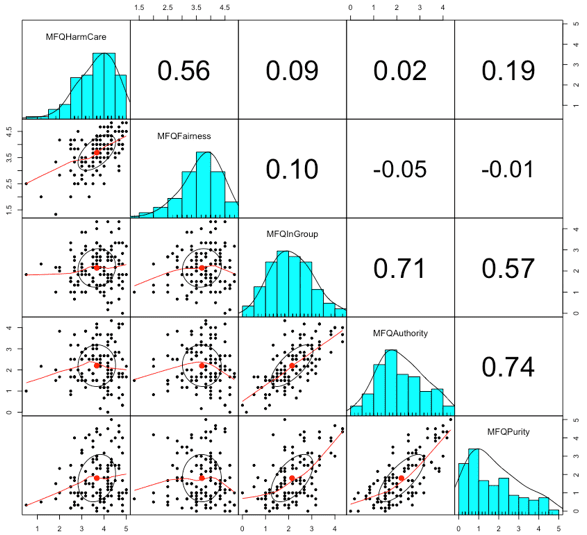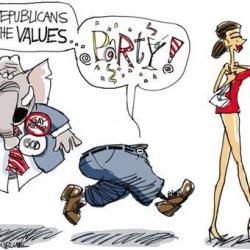I hope to have the next full instalment of my series up by next week, but in the meantime, I thought this might be of interest (would be helpful to have read part one in this series for this post to make sense:
I’m currently learning how to use R/RStudio (open-source statistical packages), so I’ve imported my dissertation SPSS data into R, and have been re-familiarising myself with it.
I thought it would be interesting to look at the correlations between the Haidt Moral Flavours, as found in my data. These scores are the ratings that people gave by using the Moral Foundations Questionnaire (MFQ: lowest score, 0; max score 5). You can see the MFQ questionnaire, itself, here.
I haven’t figured out how to get the p-values to display with the correlations, yet – and with a small sample size (n=119) it’s only indicative, anyway.

Notice the medium strength correlation between Harm/Care and Fairness, and InGroup and Purity. Note, by comparison, the very strong correlations between InGroup and Authority, and Purity and Authority. What this means is that each individual’s Harm/Care score is quite closely related to their Fairness score. Of significance is the fact that a person’s authority score is very closely related to both their In-Group and Purity scores, but those scores are less closely related to each other.
Authority, according to Schwartz, is a Power value that, according to me, is definitional of politics. Both Purity and In-Group are religious values, and both rely upon a definition of authority to have meaning. Recall that I said in my first post that religion has an underlying politics? This also has a parallel in the work of Robert Altemeyer (2006[1]) on authoritarianism, in which he finds that despite being raised in a highly religious household, an adult individual’s politics better predicts their religion/denomination, than vice versa.
It is interesting that the participants in my study self-identify as left wing (n=53, or 44.5%), centrist (n=41, or 34.5%), and right wing (n=25, or 21%), which is approximately in line with party affiliations in the US (Independents, 44%, Dems, 31%, Reps, 25%[2] – assuming that independents are mostly progressives, or swinging moderates/centrists, with a few libertarians). The belief about the close relationship between Harm/Care and Fairness, and between In-Group, Authority, and Purity, seems to be intrinsic to the concepts themselves, to the point where there are very low correlations between the “liberal” Harm/Care and Fairness, and the “conservative” In-Group, Authority, and Purity.
I’ll admit that statistics isn’t my strongest suit (which is my I’m learning R, and using it to re-learn stats), so if anyone else wants to proffer some alternative interpretations or explanations of the plots and correlations, I’m all ears.
[1] The Authoritarians – Bob Altemeyer
[2] http://www.gallup.com/poll/15370/party-affiliation.aspx – stats quoted for 2016 Apr 6-10.
Edit: corrected link for ‘The Autoriatrians’ (28/02/2018)















